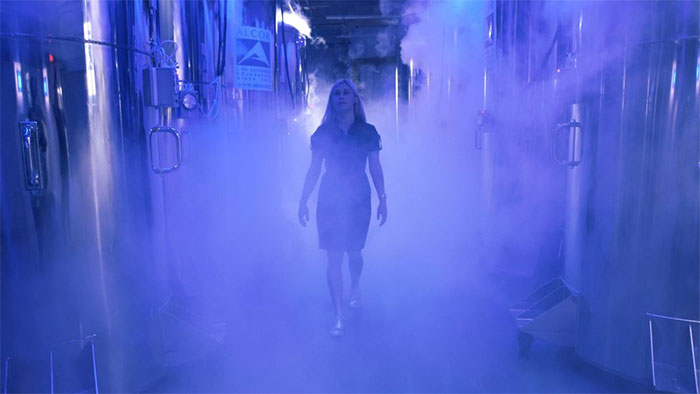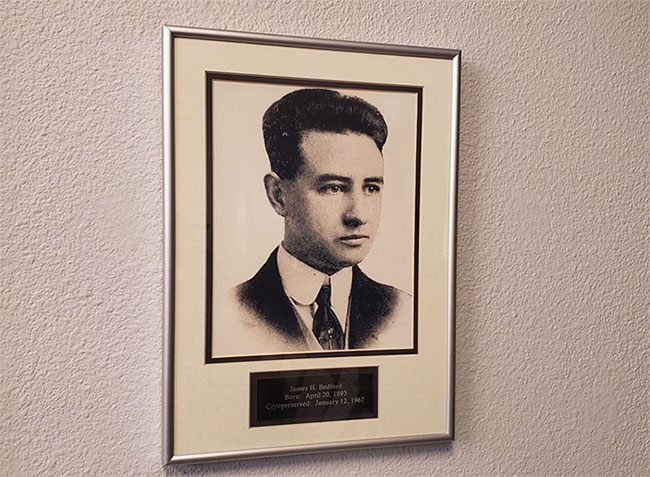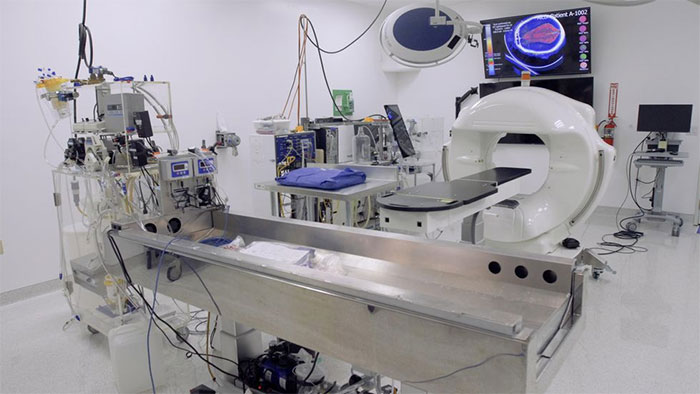Inside the world's largest body freezing facility waiting for the day of resurrection
Steel chambers, filled with liquid nitrogen, at a human body freezing facility in the US currently hold more than 170 people, with the hope that one day they can be resurrected.

Human bodies are kept inside sealed chambers made of steel.
According to Cnet, the freezing center in Scottsdale, Arizona, USA of the Alcor Life Extension Foundation is currently the largest human body freezing facility in the world.
Alcor provides the type of service that allows the preservation of human bodies in the best condition, with the hope that scientific advances will help revive these people in the future.
Alcor was founded in 1972 by Linda and Fred Chamberlain. The couple met at a cryogenic engineering conference in the early 1970s. Linda was still in college and Fred was working for NASA.

Frozen portraits of people hang on Alcor's premises.
Together, the two created an organization that could be the foundation for giving people a second chance at life.
'Our aim was to create an organization that could save people's lives and give them the opportunity to regain their health and function,' said Linda Chamberlain. 'If we knew this was so difficult, we might not have done it. But once we start, we'll stick with it."
According to Alcor, James Bedford - one of the richest people in America in the 1960s, was the first to use cryogenic technology.

The operating room, where doctors draw blood from the body and replace it with anticoagulants.
Bedford was frozen as soon as the heart stopped in 1967, five years before Alcor was founded. After being frozen, Bedford is still not considered dead, but neither is he considered alive.
Bedford has been housed at the Alcor Center since 1991.
Inside the center, one can see portraits of frozen participants. These people are listed with their names, dates of birth, and dates of being frozen with no date of death.

Alcor specialists must ensure that, prior to freezing, human cells and organs are still functional.
According to Linda Chamberlain, Alcor is always researching and improving, offering the best methods for customers who choose the frozen form.
According to Alcor, the best way to preserve the human body is through a process called vitrification. This process draws blood and fluid from the body's cells and replaces it with a medical-grade anticoagulant.
This way, when one's body temperature drops below zero, the body goes into a glass-like state, rather than frozen solid.

The chambers filled with liquid nitrogen hold the human body.
In this state, Alcor says the human body has been perfectly preserved for decades. Those brought to Alcor for cryosurgery were pre-registered, diagnosed as clinically dead, intubated, and with blood still circulating throughout the body.
'Death comes when your heart stops beating, your lungs stop breathing without intervention,' Linda said. 'Here the body functions are still intact, the organs have not died'.
Inside Alcor's operating room, bodies are prepared for 'long-term care'. The process of withdrawing blood instead of anticoagulants can take hours.

This method helps to preserve the human body in its perfect form when it was alive.
Alcor offers a price of 220,000 USD for those who want to preserve the whole body and 80,000 USD for the case of preserving only the head.
Once a person's body temperature is lowered to minus 169 degrees Celsius by immersion in liquid nitrogen, they are taken to the long-term care room.
In this room, each metal chamber filled with liquid nitrogen will hold nine human bodies. Alcor is storing the bodies of more than 170 people in total.

The cost to freeze the entire human body, waiting for the day of resurrection is 220,000 USD.
The bodies were preserved in the form of hanging upside down. Hanging the body upside down is for safety reasons. In the event of a liquid nitrogen leak, the most important tip will be the last to be affected.
Alcor injects more liquid nitrogen into the metal chamber every few weeks, checking the temperature condition with a computer.
Today, the technique of freezing the human body is quite complete. But how to bring that person back to life is still a dream.
People today still do not fully understand the brain, let alone the technology to revive someone.
But Alcor is optimistic. 'We predict that in 50-100 years, we will have reached the medical technology to revive frozen people to full health and function as usual,' Linda said.
Proponents of cauterization argue that death is a process and not simply the moment the heart stops beating. However, the industry has long been criticized as "fake science" or even a scam.
One of the bodies frozen by Alcor was that of baby Matheryn Naovaratpong, also known as Einz, who died of brain cancer in 2015, just before her third birthday. Einz's parents Nareerat and Sahatorn from Thailand decided to preserve their daughter's brain. Einz had undergone 10 surgeries, 12 rounds of chemotherapy and 20 rounds of radiation therapy but still could not overcome the cancer. Realizing that there is no hope for a cure for his daughter, Sahatom begins research into coagulation in hopes of convincing his wife that their daughter may have a new life in the future.
"This is the way to keep her, we have to keep her," Sahatorn said.
At first, the whole family rejected the idea, but Sahatorn spent months persuading them.
"Then we can prevent death? Yes. Can you believe we will prevent it? That's what I had to convince my family. I convinced my wife for months and finally. and she agreed."
The couple started recording videos for their daughter in the hope that she could see them in the future. Meanwhile, Alcor's team had flown to Thailand when Einz passed away. In order for the freezing process to be as successful as possible, experts say it is best to start the freezing process within 60 seconds when the heart begins to stop beating.
"I told her to come back and be my daughter again. I love you so much," Nareerat said before her daughter's body was frozen and shipped to Arizona.
- Discover the world's largest frozen, deadly resurrection facility
- Australia built a frozen facility awaiting its resurrection
- What is the frozen man more than 50 years waiting to revive now?
- Inside the frozen facilities waiting for revival
- Freezing brain science Russian genius waiting for revival day
- 'Accurate' at -196 degrees C: Humanity is taking a step to immortality?
- The service freezes the body of a dead person to await resurrection
- Frozen brain awaits resurrection in the future
- Brain freezing service waiting for revival for $ 100,000
- China built the world's largest quantum facility
- Summary of 'hot' news on May 3 week
- How was the first frozen body in China handled?
 Norway built the world's tallest wooden tower
Norway built the world's tallest wooden tower Kremlin
Kremlin Ashurbanipal: The oldest royal library in the world
Ashurbanipal: The oldest royal library in the world Decoding the thousand-year construction of Qin Shihuang shocked the world
Decoding the thousand-year construction of Qin Shihuang shocked the world